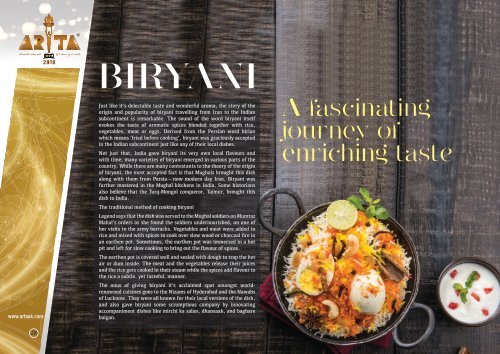ARTA Magazine
Asian Restaurant and Takeaway Awards (ARTA), the most prestigious celebration of South Asian cuisine in the UK. The Asian catering industry is valued at approximately £5 billion. Even so, over the years the industry has witnessed a steep downturn. This decline is largely attributed to the shortage of skilled workers in the hospitality sector, from a lack of talented chefs all the way through to front of house staff. This is due to the UK’s stringent immigration policy relating to skilled workers from outside the EU, coupled with a palpable sense of disinterest among younger people or job seekers with regard to the hospitality sector. The ARTA initiative has involved addressing this insufficiency. Through reaching out to current and prospective students at the regional cook-offs, ARTA has established a program of youth engagement that will help revitalise the food industry by targeting a demographic that is crucial to the future prosperity of the sector. As ARTA has been working with colleges nationwide, it has introduced the industry and prospective workers to one another, inspiring a symbiotic relationship.
Asian Restaurant and Takeaway Awards (ARTA), the most prestigious celebration of South Asian cuisine in the UK. The Asian catering industry is valued at approximately £5 billion. Even so, over the years the industry has witnessed a steep downturn. This decline is largely attributed to the shortage of skilled workers in the hospitality sector, from a lack of talented chefs all the way through to front of house staff. This is due to the UK’s stringent immigration policy relating to skilled workers from outside the EU, coupled with a palpable sense of disinterest among younger people or job seekers with regard to the hospitality sector. The ARTA initiative has involved addressing this insufficiency. Through reaching out to current and prospective students at the regional cook-offs, ARTA has established a program of youth engagement that will help revitalise the food industry by targeting a demographic that is crucial to the future prosperity of the sector. As ARTA has been working with colleges nationwide, it has introduced the industry and prospective workers to one another, inspiring a symbiotic relationship.
Create successful ePaper yourself
Turn your PDF publications into a flip-book with our unique Google optimized e-Paper software.
BIRYANI<br />
www.artauk.com<br />
28<br />
Just like it’s delectable taste and wonderful aroma, the story of the<br />
origin and popularity of biryani travelling from Iran to the Indian<br />
subcontinent is remarkable. The sound of the word biryani itself<br />
evokes the taste of aromatic spices blended together with rice,<br />
vegetables, meat or eggs. Derived from the Persian word birian<br />
which means ‘fried before cooking’, biryani was graciously accepted<br />
in the Indian subcontinent just like any of their local dishes.<br />
Not just that, India gave biryani its very own local flavours and<br />
with time, many varieties of biryani emerged in various parts of the<br />
country. While there are many contestants to the theory of the origin<br />
of biryani, the most accepted fact is that Mughals brought this dish<br />
along with them from Persia - now modern day Iran. Biryani was<br />
further mastered in the Mughal kitchens in India. Some historians<br />
also believe that the Turq-Mongol conqueror, Taimur, brought this<br />
dish to India.<br />
The traditional method of cooking biryani<br />
Legend says that the dish was served to the Mughal soldiers on Mumtaz<br />
Mahal’s orders as she found the soldiers undernourished, on one of<br />
her visits to the army barracks. Vegetables and meat were added to<br />
rice and mixed with spices to cook over slow wood or charcoal fire in<br />
an earthen pot. Sometimes, the earthen pot was immersed in a hot<br />
pit and left for slow cooking to bring out the flavour of spices.<br />
The earthen pot is covered well and sealed with dough to trap the hot<br />
air or dum inside. The meat and the vegetables release their juices<br />
and the rice gets cooked in their steam while the spices add flavour to<br />
the rice a subtle, yet tasteful, manner.<br />
The onus of giving biryani it’s acclaimed spot amongst worldrenowned<br />
cuisines goes to the Nizams of Hyderabad and the Nawabs<br />
of Lucknow. They were all known for their local versions of the dish,<br />
and also gave biryani some scrumptious company by innovating<br />
accompaniment dishes like mirchi ka salan, dhansaak, and baghare<br />
baigan.<br />
A fascinating<br />
journey of<br />
enriching taste


